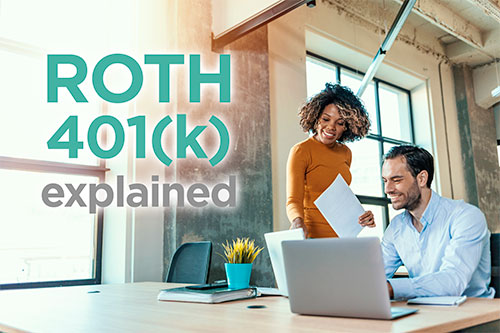The Roth 401(k) Explained
The Roth 401(k) is an employer-sponsored retirement plan with these characteristics:
- It is a retirement account offered by employers with contributions that grow tax free over time.
- The contributions are made with after-tax dollars, which allows post-retirement withdrawals to be tax free.
- It combines elements of the traditional 401(k) and the Roth IRA.
The main difference between the Roth and the regular 401(k) is that Roth contributions are made with after-tax dollars while regular 401(k) contributions are with pre-tax dollars.
How does a Roth 401(k) work?
The employer establishes the retirement plan and offers it to employees. The employer also selects the investment options. As contributions are with after-tax dollars, the advantage is for those who expect higher tax rates in retirement. They can pay tax now and avoid it on withdrawals in retirement.
Some rules that come with a Roth 401(k):
- You must be at least 59 ½ years of age to withdraw tax free.
- For 2021, contributions can be as high as $19,500 with an additional $6,500 if you are older than 50 years of age.
- You are required to begin to start making withdrawals by age 72.
- Must have had the account open at least 5 years to begin withdrawals at 59 ½.
Always check with a tax advisor for current regulations regarding the Roth 401(k) before starting an account.
Benefits of the Roth 401(k):
As already mentioned, the two major benefits of the Roth 401(k) are tax free growth of money in the account and tax free withdrawals in retirement. This can have a significant effect on income in retirement for high income earners and those with large retirement and investment accounts. If they expect high incomes in retirement, the Roth account withdrawals will not be taxable.
Here is a quick reference chart comparing the Traditional 401(k) to the Roth 401(k):
Roth 401(k)
| Traditional 401(k)
|
The good news is that you do not necessarily have to choose one or the other. In some companies and situations, you may have one of each. However, the annual contribution limit in total is $19,500. This means that if you deposit $9,000 to one account, you can only contribute up to $10,500 to the other.
For those who are fortunate enough to have one of each of the two accounts and the income for maximum contributions, there is leverage once in retirement. Withdrawals can be selected by account type based on the current year’s tax liability.
The analysis of current and future advantages and disadvantages of these retirement accounts can involve some careful planning. Consult with a tax advisor to get the most current rules and discuss your choices.

